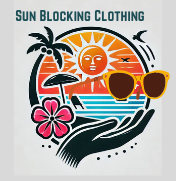
Will the color of my shirt improve sun protection? Make my skin safer in the sun? Yes, the color can make a difference. But there is more to skin protection from the sun than the color of your shirt.
Witnessing my children face skin cancer struggles intensified my commitment to break the cycle. For the past four years, I’ve immersed myself in the study of sun blocking clothing, driven by a singular purpose: to put an end to the relentless cycle of skin cancer for my grandkids and generations to come.
Understanding how color can be an important part of sun-smart style enables you to do a better job of choosing colors for effective skin protection.
If your sun blocking wardrobe has a weak spot in it, don’t let that spot be color. The color of a garment can make a difference. Protecting your skin from the sun is not a one-step action.
Where to Start Your Skin Protection from the Sun
In the pursuit of sun safety, we often turn to sunscreen.
Sunglasses and sun hats are also our primary defenses. According to the activity that takes you outside, hats and sunglasses can be the most important.
If you are swimming, and stay in the water, obviously, sunscreen is the go too. The parts of you underwater, the body from the waist down will only get filtered sun.
The parts of you, from the waist up will need more protection. Remember to reapply sunscreen more often. Sun rashers and other swim tops should cover the trunk of your body and arms, plus your neck. These are the places that usually will sunburn.
When the garment is wet, there will be less protection, so sit in the shade while the swim top drys. Then you will again have the safety of sun blocking clothing to help you protect yourself from the sun.
Seems that most people forget to check their skin protection from the sun in normal everyday situations. Working in the yard. Participating in outdoor sports, and commuting to work. In our part of the world, people have lots of outdoor chores with animals.
Remember, when you leave the house you will need sun protection by 10 AM or so. Our sun is in full-out skin damage mode by 10 AM and stays that way until 4 PM. Even in the cooler seasons of the year.
A hat and sunglasses along with the sun blocking long-sleeve shirt will cut your risks of skin cancer.

What Part Does Color Play
Color is one crucial aspect that is frequently overlooked.
The color of our clothing can make a difference, especially if it is normal clothing from our closet.
If the clothing we wear is rated UPF clothing that has been manufactured to block the sun, color plays little part in the protection. Color will affect how cool, or how warm you are in the sun.
In the case of UPF clothing, darker colors will keep you warmer. Lighter colors and white will allow you to be a bit cooler while wearing the garment.
So a white shirt rated UPF 50 will protect your body as well as a navy blue one that is also rated UPF 50. You will need sunscreen on your face if you choose white because of the reflections of the sun’s rays.
The colors you choose play a more important role in helping to shield your skin from the sun’s harmful rays when wearing normal clothing.
Now let’s look at how color and sun protection work.
How Does Color and Sun Protection Work
First, there is knowing how different colors react to sunlight.
Then, knowing about fabric the part of the yarns used in weaving the material.
You can use your existing wardrobe to create a stylish, comfortable, but sun-smart ensemble. This helps you be ready for whatever you are doing when you are exposing your skin to the sun.
Sunlight consists of ultraviolet (UV) radiation, comprised of UVA and UVB rays. There are other UV rays, but most are not strong enough to do skin damage unless you are out for an extreme amount of time.
What we must be cautious of is the various skin concerns, including sunburn and premature aging.
What do Dark Colors do
Dark colors because of their maximum absorption of UV rays can be a great choice.
- Dark colors, such as black, navy, and dark brown, do a better job of absorbing UV radiation. This absorption acts as a shield, preventing harmful rays from reaching the skin. When considering your sun-blocking wardrobe, using darker colors provides an effective first line of defense.
For my sun protection, I wear jeans when I am out on the bleachers at a ball game. Yes, this gets hot. So I use an umbrella over my upper legs and knees. This is where the fabric is pulled tight when I sit. The tight fabric is more apt to have some weave holes (where the yarns cross each other) that will allow the sun through.
Last Saturday when I attended my Grandson’s game it was 93* and bright sun. My loose-fitting shirt kept the sun off my body, but my upper thighs and knees were burning. The dark denim was absorbing the UV rays. With the fabric pulled tight because I was sitting, I would have been a sitting duck for the sunburn.
Fortunately adding the umbrella over my lower lap was the extra layer I needed.
I did have my sun blocking hat and sunglasses as well. The next day I am glad to say there was no burning anywhere, and no extra freckles. I did apply sunscreen first thing in the morning like always.
What About Bright Colors
Do you prefer the bright colors? Some will also absorb some of the UV rays from the sun, as well as some will reflect.
While bright colors do absorb some of the UV rays, if your fabric isn’t very tightly woven, there will be a good bit to get through to your skin. Remember those weave holes?
Vibrant and bright colors should be coupled with fabrics incorporating UPF (Ultraviolet Protection Factor) technology.
This combination will offer a stylish alternative without compromising on sun protection. Polyester yarns are often combined with cotton or linen to make a better sun blocking fabric.
These fabrics, manmade or blends improve the garment’s ability to block UV rays. This makes them a valuable addition to a sun-smart wardrobe.
How do you know the fabric used? Check the label of the garment.

Let’s See How Light Colors Work
Light colors work as cooling effects during the warmer times of the year. As the UV in the sun rays is reflected instead of absorbed, the garment is usually cooler to wear.
- Light-colored clothing, including whites, pastels, and light blues, reflects sunlight, resulting in a cooling effect. While not as effective as dark colors, they still contribute to sun protection and are especially suitable for warm weather.
As the UV rays are reflected, consider where these rays are landing. Be sure your face has sunscreen and that it is reapplied often.
If your sun hat is a really light color, be sure and use sunscreen. The underside of the brim will reflect on your face, leaving a sunburn.
Are Prints and Patterns OK for Sun Protection
Then we need to consider the clothing made of printed and patterned fabrics. Not all garments are solid colors. Where do these items fit in the protection plan?
Prints and patterns work for enhanced protection from the sun.
- The world of prints and patterns isn’t just about aesthetics; it can significantly contribute to sun protection. Small, dense patterns with multiple colors create a mosaic effect, dispersing UV rays and providing an additional layer of defense against sun damage.
If these garments are made of synthetic fabrics they can be very effective in helping protect your skin from the sun.
What about light colors?

What About Fabric
Fabric matters in building your sun blocking wardrobe.
- Regardless of color, the type of fabric matters. Tightly woven fabrics, such as denim or canvas, create a more effective barrier against UV rays.
However, denim and canvas tend to be warmer to wear. In the winter, that warmth is appreciated. In the summer, not so much. So what are we to do?
Learn to read labels. Often people who are not interested in sewing don’t pay attention to fabric content. The polyester that is mentioned earlier is an answer for you if you are not quite ready to invest in a new UPF wardrobe.
Regular fabrics that are made of poly and cotton can prove to be quite protective for blocking the sun. Look for shirts that aren’t worn out.
Any cloth that shows signs of wear will be less protective. When clothing is worn and breaking down, has extremely faded areas, or other signs of age, they should not be considered sun blocking.
The same goes for knits, like tee shirts. A new dark-colored polyester tee shirt will give you a fair amount of protection. That favorite tee shirt that is faded and shows that it is older? Don’t depend on that one for protection in the sun
- Additionally, fabrics treated with UPF provide an extra layer of sun-blocking capabilities.
The UPF-treated ones will have their protection level on the tags and labels.
Remember which of your sun blocking garments are the better at protection. Those are the items to reach for when you are going to be exposed to the sun. Knowing ahead of time will make the best selections automatic, and your skin protection for the sun more complete.
Sun-Savvy Wardrobe Tips
Layering for versatility is often overlooked.
- Creating a sun-smart wardrobe doesn’t mean sacrificing style.
- Consider layering different colors and fabrics for a versatile and effective combination.
- Pairing a UPF-rated, light-colored shirt with a darker outer layer enhances both protection and style.
Using your basic sun hat and sunglasses to start your sun protection wardrobe protection will give you more ways to express your personal style and still stay protected.
- Sun hats and sunglasses are fundamental elements of a sun-blocking wardrobe. Opt for a wide-brimmed hat for face and neck coverage.
- Choose sunglasses with UV protection and oversized lenses or a wrap-a-round style to shield your eyes from harmful rays.

Use What You Have
Using what’s already in your closet will give you more variety now that you are aware of the best fabric and color choice.
Color can definitely boost your choices for sun protection clothing.
- A key aspect of sun-savvy dressing is making the most of what you already have.
- Assess your existing wardrobe and identify dark-colored pieces that can serve as effective sun blockers. Combine them with lighter colors and patterns to create stylish, layered looks that prioritize sun protection.
To help protect your skin from the sun, dermatologists recommend wearing the following items: Lightweight and long-sleeved shirts and pants. It’s important to cover up as much of your skin as possible when spending time outdoors. When selecting clothing, avoid fabrics with a loose or open weave, such as lace. (Skincancer.org)
The most important thing is, don’t allow the sun to damage your bare skin. Even if you don’t have the “right” garment to wear, something is better than nothing.
How Different Colors React to the Sun
Now let’s reinforce how the sun affects the colors we might choose to wear:
- Dark Colors (Black, Navy, Dark Brown):
- Absorb a significant amount of sunlight, providing excellent protection against UV radiation.
- Bright Colors (Reds, Yellows, Oranges):
- Reflect more sunlight, offering protection by bouncing sunlight away from the body.
- Light Colors (White, Light Blue, Pastels):
- Reflect sunlight, providing a cooling effect and some level of sun protection.
- Prints and Patterns:
- Create a dispersion effect, scattering UV rays and contributing to enhanced sun protection.
- Fabric Matters:
- Tightly woven fabrics offer better sun protection, and UPF-infused fabrics provide additional shielding against UV radiation.

Sami’s Take on “Will the Color of My Shirt Improve Sun Protection
Mastering your sun-savvy style involves not only getting to know how color works in your skin protection plan. It also includes conscious choices for protecting your skin from the sun.
Dark colors, bright hues, light tones, and strategic patterns can all contribute to your ability to protect your skin from the sun damage that occurs with exposure.
Wide-brimmed hats and UV-protective sunglasses should be the basics of what you buy first.
Additionally, make the most of what’s already in your closet.
Work with the power of color. You can fashionably prioritize the health of your skin, and reduce your risk of skin cancer.
Thanks for reading,
Sami
References:
- American Academy of Dermatology. (https://www.aad.org/public/everyday-care/sun-protection/)
- Skin Cancer Foundation. (https://www.skincancer.org/)
